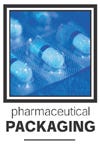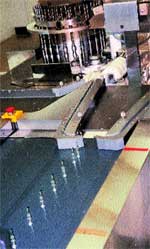Applying tiny labels is a challenge
| |
After the label is applied to the ampule, it is rotated against a stationary section by a horizontal belt mounted on edge, top photo. Labels pass through a hot-stamp coding machine, bottom, that applies lot code and expiration date. |
Akorn, Inc. fills, seals and sterilizes product in ampules, syringes and vials at one plant in Decatur, IL, and then sends the filled containers to a

second plant in Decatur for inspection and labeling. Last June, Akorn installed a new line at the labeling plant to run ampules ranging in size from 1 to 20 mL at 135 units per minute. It was running the 1-mL size during Packaging Digest's visit.
One of the key pieces of equipment on the line is a Model 6VAL automatic labeler from Newman Machinery. "We got involved with Newman initially for this project because we already had some of their labelers, and we're very happy with our decision. We had some very specific things we wanted, and Newman is very flexible and easy to work with when you tell them your specific needs," says plant manager Joe Hardy. "The machine has required very little maintenance since we started running it, and they've given us great service."
Ampules enter the labeler in a straight line and are conveyed to the label application point. A roll of labels is mounted horizontally on the backside of the machine. On their way to the labeling point, the labels pass through a hot-stamp coding machine that applies a lot code and expiration date. Supplied by Thermo Allen Coding, the machine utilizes a heated die that presses a ribbon against the label, which is passing beneath, and transfers the ink to the label. The Thermo Allen hot-foil coder includes digital dwell technology with a digital dwell display to ensure application accuracy.
Labels are peeled from the web at the application point, and the leading edge is applied to the ampule, which then enters a section where a horizontal belt mounted on edge rotates the ampule against a stationary section to finish the label application. A sensor at the discharge checks for unlabeled ampules, while a TIPS SENTRI™ vision inspection system from Systech checks to ensure that the code date and lot number are correct. The TIPS SENTRI system utilizes optical character verification technology to compare the data on each label with the correct characters stored in its database. As each label is inspected, it is displayed on a video screen that is part of the vision system. Correct code dates and lot numbers have a green overlay, while incorrect ones have a red overlay.
The labeler operates in a "positive accept" mode in which every container is considered faulty and will be rejected unless the inspection systems identify it as being acceptable. A solenoid at the labeler discharge ejects all containers into a bin unless it receives signals from the inspection systems that the ampules are good. Thus, if any of the inspection systems fail, bottles are rejected. A shift register keeps track of each ampule as it is conveyed and triggers the "accept" signal. A sensor in the reject bin verifies that the appropriate container has been rejected, providing a fail-safe system. A preset number of consecutive rejects will stop the machine.
The labeler is controlled by an Allen-Bradley programmable logic controller with a touchscreen operator interface. There are two modes of machine operation. Run Mode allows the operator to start and stop the machine, reset fault messages, and view counters and speed indicators. Key-locked for line security, the machine will only operate in this mode with all specified security systems functional. Setup Mode, which is accessed via the key-switch, permits setting shift registers, counters, systems overrides and speed control. Count data can be accessed by the operator to show batch size, total product in and out of the machine, labels dispensed, containers rejected and rejects by type of fault (such as bar code).
| |
The inspection system utilizes light passing through the spinning ampule to detect particulates in the product. |
As a quality control aid, the labeler incorporates an In Process Control (IPC) function that permits the security systems to be challenged during production. With the machine in Run Mode, the IPC can be accessed by inserting a separate IPC key and pressing the IPC button on the keypad. An instruction can be given NOT to print data on a label, or NOT to label a container. The faulty container will then be tracked through to the reject station by the normal security systems, so the operator can determine that all systems are operating properly. Thus, periodic validation is achievable at full speed without losing production time.
Ampules leaving the labeler are checkweighed by an Icore II unit from Thermo Ramsey Technology, and are then packed by hand into cartons.
Inspects for particulates by passing light through spinning bottles
Filled, sealed and sterilized ampules are delivered to the labeling plant in cases, and workers place them on the infeed conveyor manually. The first machine in the line is a model EIS 596 product inspection system from Eisai, which inspects for particulates in the colorless product.
| |
Inspected ampules leave the product inspection system on their way to the glass inspection unit. |
Eisai's Automatic Inspection Machine uses light transmission as its detection system. This system perceives light variation caused by foreign particulates while they are rotating within the solution. Acceptance or rejection is based on the particulate's size, and not on any other factor, such as the particulate's reflective strength. Another advantage of the light-transmission system is that it is free from the influence of stains, flaws, labels on the container surface, or similar factors. Thus, rejection of qualified products is avoided.
After being fed onto the infeed table, the containers are transported to the infeed starwheel, which feeds them into the inspection unit, consisting of a rotating turret with 24 turntables. After an ampule is placed on a turntable, a rod descends to hold it in place. As the turret rotates, the container is spun at high speed to impart a spin to the solution inside. The spin is stopped just before the container enters the inspection beam of light, but the solution inside the container, along with any particulates, is still moving. If any particulate is present, it blocks the light. The sensor perceives the light variation caused by the particulate and judges the container acceptable or faulty in accordance with the preset sensitivity level.
The machine also checks that the proper volume of product is in the container. In the light-transmission system, the meniscus of the solution casts a shadow 1- to 2-mm wide. The sensor judges a container as acceptable when the shadow is cast within a preset spectrum. Underfilled, overfilled, or empty containers are automatically sorted out.
Eisai's Automatic Inspection Machine features one-touch parameter setup through menu-driven software. It is equipped with a number of self-monitoring devices that warn the operator when there is any malfunction in key operation points, such as the power source for the electronic circuits, the inspection beam intensity, the spin belts, the inspection turntable, and so on. Any malfunction causes a warning buzzer to sound, and the machine automatically stops, while a corresponding red lamp on the display panel indicates the source of the trouble.
After inspection, the containers discharge through a starwheel and screw conveyer. Those containers judged faulty during inspection are diverted into a hopper.
Leak detector inspects for pinhole leaks
The next stage after product inspection is container inspection, which is done by a Model HDB-II-AS+DL pinhole inspector from Nikka Densok Ltd. It utilizes a high-frequency spark method of inspection that is non-destructive and causes no secondary contamination of the product. This detection principle of High Voltage Leak Detection (HVLD) can detect pinholes as small as 0.5 micron in diameter. And, since the HVLD system is using the product in the container as a conductive path, small pinholes, which would normally be closed by the product, will be detected. This enables a more consistent and efficient way of detecting leaks while reducing the possibility of false rejection.
HVLD is based on the principle of a high-voltage spark-test system. It is capable of handling any product as long as the container is made of electrically insulated material, such as glass, rubber, plastic or plastic film, and contains an electrically conductive solution. Multiple areas of containers can be inspected by using multiple electrodes.
In this process, high-frequency, high-voltage electricity is applied to a specific area of the hermetically sealed container by electrodes. If a pinhole, crack or other defect is present, the discharge current will flow through the defect into the inside of the container and will be detected at the detection electrode, which sends a signal to the detection circuit. Detecting this current is evidence of the defect. The detected signal is displayed on the unit's analog indicator or digital signal display. The system's PLC activates alarm signals and other output signals for general operation. The HVLD system is a validatable process and has been recognized by the FDA as a 100-percent in-line testing device for seal integrity.
Akorn has a system that inspects four areas of each ampule with four separate electrode systems. In order, the four electrodes inspect the score line where the top will be snapped off, the body, the bottom, and the tip of the ampule. Ampules are delivered to the system through a starwheel into a feedscrew that meters them into the intermittent-motion pinhole detector. The ampules are laid on their sides, and the machine stops while they are tested. Ampules exit the machine through a discharge screw, which delivers them to a starwheel that diverts faulty ampules to a reject conveyor. Acceptable ampules move into a second starwheel that delivers them to the discharge conveyor.
More information is available:
Labeler: Newman Labeling Machines, Inc. 858/622-8928. Circle No. 225.
Hot-stamp coding: Thermo Allen Coding, 763/783-2734. Circle No. 226.
Vision inspection system: Systech, 609/395-8400. Circle No. 227.
PLC: Allen-Bradley, 414/382-2000. Circle No. 228.
Checkweigher: Thermo Ramsey Technology, Inc., 763/783-25600. Circle No. 229.
Product inspector: Eisai U.S.A., Inc., 201/692-0999. Circle No. 230.
Ampule inspector: Nikka Densok USA, Inc., 303/202-6190. Circle No. 231.
About the Author(s)
You May Also Like





